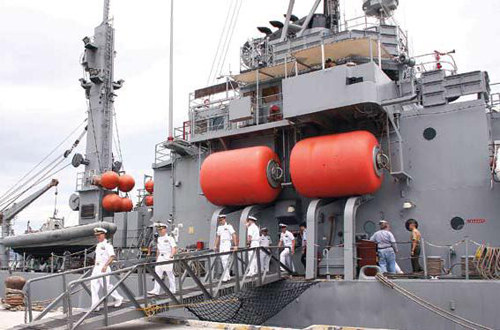|
 |
|
ONSHORE: Soldiers disembark from the U.S. rescue and salvage ship USNS Safeguard at a port in Da Nang on July 15. The ship, along with two other U.S. warships, came to conduct joint military exercises with the Vietnamese Navy (LI LIN) |
U.S. intervention unwelcome
The South China Sea dispute focuses on three aspects: ownership of the Nansha Islands, use of marine resources and freedom of navigation. The first two aspects have nothing to do with the United States, so it had grasped the third—freedom of navigation, trying to give a certain legitimacy to its involvement in the South China Sea issue, Jin said.
China has indisputable sovereignty over the islands in the South China Sea and their surrounding waters. Freedom of navigation by the United States has never been a problem in the area, said Cai Penghong, a researcher on Asia-Pacific studies with the Shanghai Academy of Social Sciences.
On the South China Sea issue, China firmly opposes the intervention of the United States and other countries, Cai said.
"The possibility is not excluded that some ASEAN member countries, for their own interests, turn to the United States with the purpose of containing China's strength in the region. We believe ASEAN as a whole will not allow the United States to dominate the issue," he said.
There are channels for China and the United States to carry out anti-piracy patrols, humanitarian assistance and other non-traditional security cooperation in the South China Sea, Cai said.
"Navigation in the South China Sea is free and the international shipping lanes are safe," said Chinese Foreign Minister Yang Jiechi on July 23 during the ASEAN Regional Forum Foreign Ministers' Meeting. "It is fair to say that countries in and outside the region all benefit from freedom of navigation and safety in the area."
The disputes over some islands and reefs and maritime delimitation of the South China Sea are one issue. Freedom of navigation in the South China Sea is a separate issue. The two issues should not be mixed up, Yang said.
"Countries in the region should enhance connectivity and increase trade," Yang said. "Countries outside the region, particularly developed economies, should make full use of the convenience brought about by freedom of navigation to step up mutually beneficial cooperation and support the progress and prosperity of the developing countries in the region."
Documents
The Declaration on the Conduct of Parties in the South China Sea was signed by China and ASEAN countries on November 4, 2002 during the Eighth ASEAN Summit in Phnom Penh, Cambodia. It stresses solving the South China Sea dispute through peaceful means. Before settlement of the dispute, the parties involved should show restraint and not take actions that will complicate the dispute. It is the first political document signed by China and ASEAN on the South China Sea issue.
The Agreement Between China and Viet Nam on the Delimitation of the Territorial Sea, Exclusive Economic Zone and Continental Shelf of the Two Countries in the Beibu Bay and The Agreement Between China and Viet Nam on Fishery Cooperation in the Beibu Bay were signed in Beijing on December 25, 2000 and came into effect on June 30, 2004. The former is the first maritime border agreement China has signed with a neighboring country. The Beibu Bay, shared by China and Viet Nam, lies in the northwest of the South China Sea.
The Tripartite Agreement for Joint Marine Seismic Undertakings in the Agreement Area in the South Sea was signed on the March 14, 2005 in Manila, the Philippines, by the China National Offshore Oil Corp., the Viet Nam Oil and Gas Corp., and the Philippine National Oil Co. It marked the first step taken by the countries to put aside territorial disputes and engage in joint resource exploration. | 